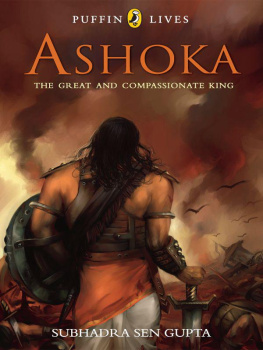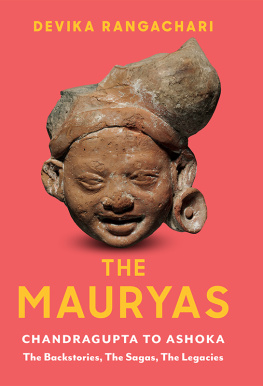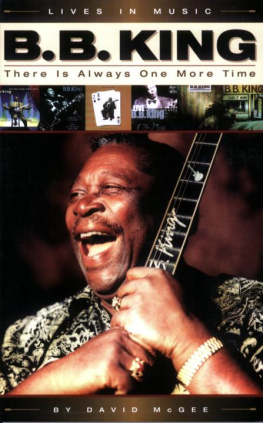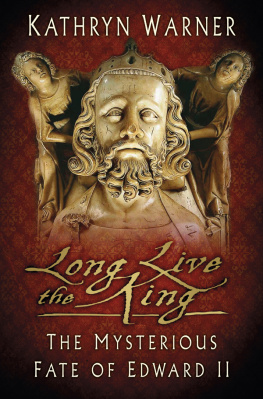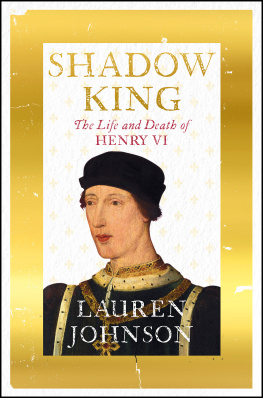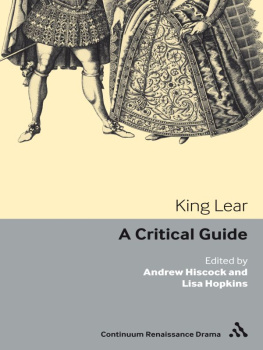King of Magadha Aśoka - Puffin Lives: Ashoka: The Great and Compassionate King
Here you can read online King of Magadha Aśoka - Puffin Lives: Ashoka: The Great and Compassionate King full text of the book (entire story) in english for free. Download pdf and epub, get meaning, cover and reviews about this ebook. City: Array, year: 2009, publisher: Penguin Books Ltd;Penguin Books India;Puffin, genre: Non-fiction. Description of the work, (preface) as well as reviews are available. Best literature library LitArk.com created for fans of good reading and offers a wide selection of genres:
Romance novel
Science fiction
Adventure
Detective
Science
History
Home and family
Prose
Art
Politics
Computer
Non-fiction
Religion
Business
Children
Humor
Choose a favorite category and find really read worthwhile books. Enjoy immersion in the world of imagination, feel the emotions of the characters or learn something new for yourself, make an fascinating discovery.
- Book:Puffin Lives: Ashoka: The Great and Compassionate King
- Author:
- Publisher:Penguin Books Ltd;Penguin Books India;Puffin
- Genre:
- Year:2009
- City:Array
- Rating:4 / 5
- Favourites:Add to favourites
- Your mark:
- 80
- 1
- 2
- 3
- 4
- 5
Puffin Lives: Ashoka: The Great and Compassionate King: summary, description and annotation
We offer to read an annotation, description, summary or preface (depends on what the author of the book "Puffin Lives: Ashoka: The Great and Compassionate King" wrote himself). If you haven't found the necessary information about the book — write in the comments, we will try to find it.
Puffin Lives: Ashoka: The Great and Compassionate King — read online for free the complete book (whole text) full work
Below is the text of the book, divided by pages. System saving the place of the last page read, allows you to conveniently read the book "Puffin Lives: Ashoka: The Great and Compassionate King" online for free, without having to search again every time where you left off. Put a bookmark, and you can go to the page where you finished reading at any time.
Font size:
Interval:
Bookmark:

The Great and Compassionate King

PUFFIN BOOKS

 I am the history bug. Watch out for me in this book as I bring to you interesting facts and unusual trivia from the past.
I am the history bug. Watch out for me in this book as I bring to you interesting facts and unusual trivia from the past.
PUFFIN BOOKS
Subhadra Sen Gupta became interested in history as she grew up in Old Delhi in the shadow of the Red Fort. So her special love is writing on history for children by making the past come alive. She writes both historical fiction and non-fiction and also detective stories, ghost tales and comic strips. Three of her books, Jodh Bai, A Clown for Tenali Rama and Twelve Oclock Ghost Stories won the White Raven Award at the Bologna Childrens Book Fair.
She has written two books for Puffin, A Flag, A Song and A Pinch of Salt: Freedom Fighters of India and Saffron, White and Green: The Amazing Story of Indias Independence.
Subhadra is always happy to answer any questions about any period of Indian history. You can email her at:
Jawaharlal Nehru: The Jewel of India
by Aditi De
Rani Lakshmibai: The Valiant Queen of Jhansi
by Deepa Agarwal

Discovering Ashoka
One of the greatest mysteries of ancient India was solved not by a historian but a scientist. When James Prinsep cracked the puzzle of an ancient script that no one could read, he swept away the curtains of time to reveal one of Indias greatest kingsa magnificent monarch who once again stood centre stage, speaking to us across a span of 2,000 years.
He called himself Devanampiya Piyadasi, or beloved of the gods and handsome in looks. We know him as Ashoka, and call him the Great. Not just because he ruled over one of the largest Indian empires but also because he was an unusually humane and compassionate king. There are only two kings in Indian history who have earned the title Greatone is the Mughal king Akbar and the other is Ashoka. The historian A.L. Basham calls him, The greatest and noblest ruler India has known and indeed one of the greatest kings of the world. And the surprising fact is that we forgot all about him for 2,000 years.
The story of the discovery of Ashoka begins in the early years of the nineteenth century when a large part of India had been conquered by the English and was ruled by the East India Company. Many young Englishmen came to this country to work and joined the administration, army, police and the trading houses. What was extraordinary about some of these men was their curiosity about the history and culture of the country they had come to rule. They learnt Persian and Sanskrit and began to translate our ancient texts into English. Others collected coins, paintings, sculptures and manuscripts and drew sketches of ancient monuments. They came as colonisers ready to rule, and fell in love with the country instead.
In 1784 Sir William Jones, an Englishman who worked for the East India Company, founded the Asiatic Society and this became the hub of all research around Indian history and culture. One of its most energetic members was an army man named Alexander Cunningham who would one day lay the foundation of the Archaeological Survey of India. It is a sad fact that even today most Indians do not show much respect for our cultural treasures like monuments, sculptures, paintings and manuscripts. We have no regret about breaking up an ancient stupa and using its bricks to build a bazaar, selling sculptures and paintings to smugglers, and letting manuscripts turn to dust. It was Englishmen like Jones and Cunningham who saved and preserved our precious heritage from ruin and wanton destruction.
While travelling around the country on work, many of these English officials had noticed tall, beautifully polished sandstone pillars that were covered in a mysterious script that no one could read. The pillars looked like ancient sentinels guarding the land, but no one knew who had put them up or why. Some of the pillars also had exquisitely carved capitals of lions, bulls and elephants, and were decorated with borders of leaves and flowers. Thinking it may be the script of some primitive form of Sanskrit, they even took the help of Brahmin scholars but no one could decipher the words.
The simple and erect letters were oddly childlike in shape, with curves, circles, straight and squiggly lines and dots. Some letters resembled stick-like human figures and one man described them as pin men. They were very unlike the curving Devanagari script used to write Sanskrit. Some scholars speculated that the writing was in Greek and described the conquests of Alexander, but they were proved wrong. These were in fact the oldest surviving written documents in India.
As a matter of fact, two centuries before, the first European to notice an Ashokan pillar was an eccentric English traveller named Thomas Coryat. He had walked from England to Delhi during the reign of Jahangir. In 1616 he spotted a pillar in Delhi soaring over the ruins of the fortress called Ferozshah Kotla that was built by Firuzshah Tughlak. The sandstone was so finely polished and shone so brightly in the sun that he thought it was made of brass. He was convinced that the inscription was in Greek and so concluded that it was in some way connected to Alexander. He got it all wrong. Alexander never got as far as Delhi and the script was Indian. Fifty years later, John Marshall, who worked in the East India Company, saw a pillar in Bihar with a carved lion on top as its capital and it also had inscriptions carved on it.
Pillars were discovered in places as distant as Delhi, Allahabad, a village in Bihar and in the jungles of Nepal. Many enthusiastic amateur historians made tracings of the inscriptions and sent them to the Asiatic Society in Calcutta. Then the same kind of writing was found carved on large rock faces and these were seen as far west as Gujarat and as far south as Mysore. Captain James Tod, who discovered the rock inscriptions at Girnar in Gujarat, described how the giant rock by the aid of an iron pen has been converted into a book. And each letter was nearly two feet high!
The mystery deepened and the excitement grew. These were obviously the messages of a mighty king who had ruled over a huge empire that not only included most of India but stretched into Nepal and Afghanistan. A search began for this mysterious monarch. Ancient Sanskrit texts, like the Puranas, often carry a long list of Hindu kings. Many temples had inscriptions on their walls by rajas describing the length and breadth of their kingdoms, but none of them seemed to fit this nameless king. What was even more baffling was how such a powerful monarch had been so completely forgotten! The only way to get some answers was to decipher those maddeningly cryptic pin men words.
Then in 1819 James Prinsep arrived in India to take up the post of Assistant Assay-Master of the Mint in Calcutta. His job was to supervise the manufacture of coins, but he also used his scientific skills to study coins and manuscripts. He liked India immensely and met eminent Indians like Rabindranath Tagores grandfather Dwarkanath, who was a rich businessman, and his friend Rammohan Roy, who was a scholar and social reformer. Prinsep was a scientific genius who had actually trained as an architect, but was given a job that required the skills of a chemist. His brother wrote that he was well grounded in chemistry, mechanics and the useful sciences. While working in Varanasi he designed a new sewer system for the city and built a new bazaar. He was also a talented artist and his delicately coloured etchings of the ghats and temples of Varanasi are still being printed in books. As a true scientist he was, in fact, curious about everything.
Font size:
Interval:
Bookmark:
Similar books «Puffin Lives: Ashoka: The Great and Compassionate King»
Look at similar books to Puffin Lives: Ashoka: The Great and Compassionate King. We have selected literature similar in name and meaning in the hope of providing readers with more options to find new, interesting, not yet read works.
Discussion, reviews of the book Puffin Lives: Ashoka: The Great and Compassionate King and just readers' own opinions. Leave your comments, write what you think about the work, its meaning or the main characters. Specify what exactly you liked and what you didn't like, and why you think so.

